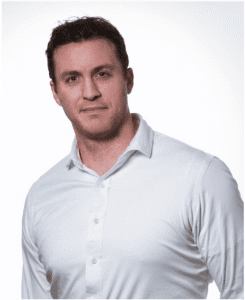Where Are They Now? Beacon Takes Aim at Eliminating Airborne Transmission
![]()
Beacon is harnessing Far-UVC technology to make indoor spaces safer, and shaping the future of public health in the process.
When the world shut down in March 2020, most people stocked up on groceries, tried to adjust to lockdown life, and waited for answers.
But for Brian Clark, cofounder and CEO of Beacon, it was the start of an entrepreneurial journey.
“Every entrepreneur wants to solve big problems,” Clark said. “And in that first week of the pandemic, I kept wondering — how has no one figured out how to eliminate airborne transmission?”

Brian Clark
Clark started to research the topic, which led him to discover Far-UVC light, a little-known ultraviolet spectrum of light that kills viruses and bacteria, but is harmless to humans. Originally developed for sterilizing wounds, Far-UVC doesn’t penetrate skin or eyes but disrupts the DNA of pathogens in the air.
Intrigued by what he found, Clark reached out to his brother, an engineer, and his sister, who is a public health expert. Following some initial brainstorming, the three decided to work together to create a first prototype.
“It wasn’t fancy,” Clark laughed. “Our first version was a metal box. But we knew we were onto something.”
That something became Beacon — a sleek, wall-mounted device, now in its fourth iteration, that silently emits invisible light to kill airborne germs. It works like a smart, connected security camera, but instead of watching over people, it protects the air they breathe.
Beacon’s early breakthrough came from an unexpected source – social media.
“We put up a website, and a TikTok creator found us and reviewed the product,” Clark said. “Within a month, we had significant revenue. It was incredible validation.”
Since then, the company has delivered devices to hundreds of customers, ranging from families with immunocompromised members to major healthcare providers. The technology has been tested many times and the results continue to improve and impress with each iteration.
But the impact goes beyond numbers.
“One customer who was immunocompromised told us they wouldn’t go to the hospital for surgery without a Beacon unit,” Clark said. “It’s hard to quantify peace of mind like that, but we’re proud to make people feel safer and healthier.”
While Beacon is led by its cutting-edge technology, Clark also credits some of his success to his time at Chicago Booth and the Polsky Center.
“Booth gave me the framework for building a business,” he said. “You can have all the grit and resilience in the world, but without strategy and structure, you’re just firing energy into a void. Booth taught me how to channel that energy into something real.”
As part of the 2015 New Venture Challenge, where he competed with his first startup — a venture-backed, first-generation AI business that later exited to private equity — he was able to lean on the Polsky Center and Booth’s network of mentors, professors, and classmates, many of whom helped shape key commercial opportunities.
![]()
“Many of the wins that we’ve had connect back to Booth,” Clark said. “The number of people willing to make introductions, share advice, or lend an ear has been a huge competitive advantage.”
Today, Beacon has expanded its team from the original three cofounders to a group of five. They’ve secured their first enterprise customer in healthcare, and new product iterations are set to launch in the coming months, offering even smarter and smaller devices.
The team was also recently named the winner of Chicago Inno’s Inno Madness, a bracket-style competition in which startups face off against one another with public votes based on which company you would invest in.
Moving forward, the company is investing in clinical research partnerships to further validate its technology and expand its applications.
“We want to change the way people think about the cross-section of health, choice, and technology,” Clark said. “We’re excited about the growth ahead and the positive impact we can have on the lives of our clients.”
// Where Are They Now? is a column featuring past program participants, investment recipients, and others who have worked closely with the Polsky Center.
Have your own story to tell? Email Darwin Minnis >>